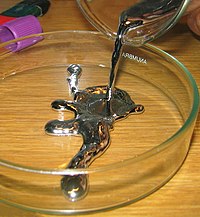
Photo from wikipedia
Abstract A three-dimensional electrode reactor was introduced into capacitive deionization (CDI). Electrosorption kinetic and the thermodynamic parameters on removal of chloride ions from aqueous solutions at various temperatures (298–323 K), anode… Click to show full abstract
Abstract A three-dimensional electrode reactor was introduced into capacitive deionization (CDI). Electrosorption kinetic and the thermodynamic parameters on removal of chloride ions from aqueous solutions at various temperatures (298–323 K), anode potentials (0.3–1.2 V), circulation velocities (75–168 mL min −1 ), pH (1–10), ionic strengths (0.028–3.028 M) and thickness of packed-bed (3.5 & 5 cm), on granular activated carbon (GAC) were studied in the three-dimensional electrode reactor. Electrosorption of chloride ions was found to be pH dependent. The result showed that the electrosorption capacity of the chloride ions increased with increasing anode potential, but decreased with increasing temperature, ionic strength and thickness of packed-bed. Batch kinetic data from experimental investigations have been described by pseudo-first-order, pseudo-second-order, external mass transfer and intraparticle diffusion models. It was found that the electrosorption of chloride ions onto GAC electrodes followed pseudo-first-order kinetics model, and intraparticle diffusion and adsorption had rate limiting effects on the electrosorption process. The value of activation energy and rate constants of electrosorption were found to reduce and increase compared to adsorption. This may be the main reasons that anode potential enhanced significantly adsorption capacity. The thermodynamics analyses indicated that the electrosorption is spontaneous and exothermic in nature.
Journal Title: Separation and Purification Technology
Year Published: 2018
Link to full text (if available)
Share on Social Media: Sign Up to like & get
recommendations!